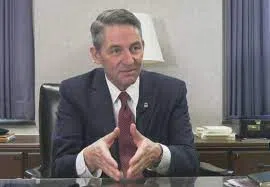
Attorney General Drew Wrigley (R-ND)
By Amy Dalrymple
BISMARCK, N.D. (North Dakota Monitor) – North Dakota Attorney General Drew Wrigley said a recent U.S. Supreme Court decision curbing the regulatory power of the executive branch could give the state a boost in its roughly 30 pending lawsuits against the federal government.
The high court’s ruling, released June 28, reverses a 40-year policy that required federal courts to defer to executive branch agencies when interpreting vague laws.
“It’s a long time coming,” Wrigley said of the decision in Loper Bright Enterprises vs. Raimondo. “This was an unwise doctrine when it was first pronounced decades back.”
The practice — often called “Chevron deference” after the Supreme Court 1984 ruling that created it — applied to how federal agencies enacted regulatory marching orders from Congress.
When Congress passes a law directing an agency to regulate something, its instructions are seldom 100% clear. The court decided in the 1984 case that federal agencies could use their own expertise to fill in the blanks in areas where the law is ambiguous.
The idea was that the agencies would know best how to interpret the will of Congress, and that the doctrine would protect them from excessive legal challenges.
The Supreme Court’s recent decision revoked this power. Now, it’s up to federal judges to interpret gray areas in legislation.
The ruling is expected to lead to significant regulatory changes as the federal government implements the new standard.
Wrigley said he expects the ruling to be largely positive for North Dakota’s spate of lawsuits against the federal government — which includes cases challenging regulations passed by the Environmental Protection Agency, Department of the Interior, Bureau of Land Management, Department of Education and more.
“This decision has taken away power from nameless, faceless bureaucrats,” he said.
The ruling could also have major impacts on the federal government’s relationships with Native tribes, said Tim Purdon, a former U.S. Attorney for North Dakota who represents tribal communities as a private practice lawyer.
“There are lots of regulations that the Bureau of Indian Affairs and the Department of Interior and places like that have historically interpreted,” he said.
Some critics of the Chevron deference are hopeful its ouster will lead to more consistency in the executive branch.
Under Chevron, the regulatory environment could swing from one extreme to the other when new presidents took office, said Paul Traynor, an assistant professor for the University of North Dakota Law School whose specialties include insurance and corporate law.
“It kind of put both the country and people in sort of a whipsaw,” he said.(His brother, Dan Traynor, is a U.S. District Court Judge for the District of North Dakota.)
The Supreme Court voted 6-3 to overturn the doctrine, with the court’s three liberal judges dissenting.
The court’s opinion, authored by Chief Justice John Roberts, states that reversing Chevron is consistent with the intent of the U.S. Constitution, which gives the federal courts the power to interpret laws.
“The Framers … anticipated that courts would often confront statutory ambiguities and expected that courts would resolve them by exercising independent legal judgment,” Roberts wrote.
The court’s liberal justices countered that federal agencies are better suited to make sense of the instructions Congress gives them.
“Congress knows that it does not — in fact cannot — write perfectly complete regulatory statutes,” Justice Elena Kagan wrote in her dissent. “It knows that those statutes will inevitably contain ambiguities that some other actor will have to resolve, and gaps that some other actor will have to fill. And it would usually prefer that actor to be the responsible agency, not a court.”
The North Dakota courts also have a history of deferring to state agencies’ interpretation of the law, according to Chief Deputy Attorney General Claire Ness.
The question remains as to whether the Supreme Court’s decision will lead North Dakota to reexamine the level of regulatory power it gives those agencies.
“I think that our state regulators … are going to have to very seriously look at the grant of authority that they have been delegated by the Legislature,” Traynor said.
The decision to overturn Chevron comes just two years after another landmark Supreme Court ruling that curbed the executive branch’s regulatory power, commonly referred to as West Virginia v. EPA. In that decision, the Supreme Court struck down an EPA rule that regulated carbon dioxide emissions by power plants. North Dakota was also a plaintiff in the case.









Comments